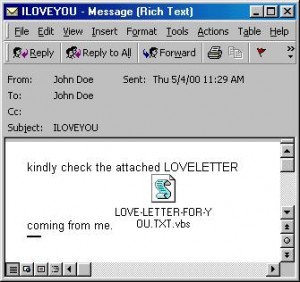Archive for 2024
Deep Blue Defeats Kasparov in Tournament Match
The IBM computer and artificial intelligence Deep Blue defeats reigning chess champion and one of the greatest chess players of all time, Garry Kasparov, in the 6th and deciding game of a tournament match, thus becoming the first time a computer defeated a chess champion in match play. A year earlier, Deep Blue had bested Kasparov in 2 individual games but Kasparov eventually won the match 4-2. This time, after being reprogrammed and upgraded, the 1997 Deep Blue, capable of calculating 200 million moves per second, won 2 matches out of 6 vs Kasparov’s 1 victory and 3 draws. After the defeat Kasparov asked for a rematch but IBM declined and retired Deep Blue.
The defeat of a reigning chess champion at the hands of artificial intelligence made headlines around the world and marked a milestone in the development of AI and machine learning. From this early landmark moment, the advancement of computing power and machine learning has created even more powerful artificial intelligence. Kasparov in 2016 stated that “Today you can buy a chess engine for your laptop that will beat Deep Blue quite easily”.
Honestly, I don’t see what the big deal is. Chess computers had been wiping the floor with me since I was in kid in the 80’s!
VisiCalc Demoed at West Coast Computer Faire
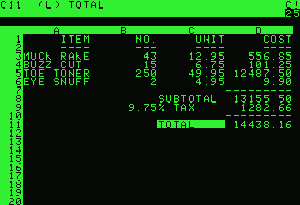
At the West Coast Computer Faire, Harvard MBA candidate Daniel Bricklin and programmer Robert Frankston give one of the first private demonstrations of VisiCalc, the original spreadsheet software. It would later be publicly demoed for the first time at the National Computer Conference in June of that year.
First released for the Apple II, VisiCalc made a business machine of the personal computer. VisiCalc was a huge success, selling more than 100,000 copies in the first year. VisiCalc also spurred the sales of the Apple II, as people would buy the Apple II just to run VisiCalc. Overall, the spreadsheet validated the usefulness of the home computer and was likely a major factor for IBM accelerating their entry into the PC market.
The Birth of Wireless
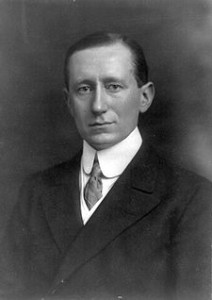
“Wireless” is born when Guglielmo Marconi sends a radio wave three-quarters of a mile. Three years later the Marconi Company will successfully communicate “ship to shore” over a distance of twelve miles. Marconi’s work leads to the commercialization and proliferation of most of the radio technologies we know today.
Linux Gets Happy Feet

Linus Torvalds describes in an e-mail to a mailing list his conception of what he believes should be the logo for the Linux operating system. This is what soon becomes Tux the penguin, the “brand character” for Linux. Perhaps had he known the movie Happy Feet would be released a little over 10 years later, he would have chosen a Warbler instead.
Germans Can Be So Dry

German scientist, Dr. Carl Gassner, is issued a German patent for the first “dry” cell battery, which uses zinc as its primary component. A U.S. patent will be issued to Gassner in 1887. Unlike previous wet cells, this dry cell is more solid, does not require maintenance, does not spill, and can be used in any orientation. Gassner’s development led to the production of the first convenient battery for widespread use and the invention of the flashlight. Gassner’s design is virtually unchanged in today’s zinc carbon “general purpose” batteries. Although most people use alkalines, in fact zinc carbon batteries will last longer in low drain devices such as remote controls and clocks.
IBM 704 Introduced
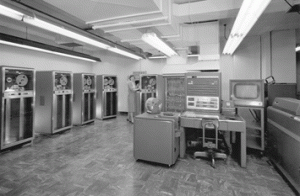
IBM announces the IBM 704 Data Processing System, the world’s first mass produced computer to feature floating point arithmetic hardware. Besides this ultra-geeky distinction, the IBM 704 will leave its mark in computer history before it is discontinued on April 7, 1960. Both the FORTRAN and LISP programming languages were first developed for the IBM 704, as well as the first music application, MUSIC. Physicist John Larry Kelly, Jr. of Bell Labs will synthesize speech for the first time in history on an IBM 704. Not bad for a mainframe.
“i” is for Apple
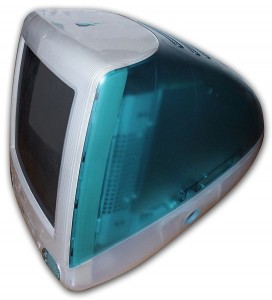
At the Flint Center Theater, the same place where the Macintosh was first unveiled in 1984, Steve Jobs introduces the original iMac. This iMac was later referred to as the “Bondi Blue”, after the color of its case (named for a beach in Australia). According to Jobs, the iMac is “the Internet-age computer for the rest of us.” By reimagining and reintroducing the simplicity of the all-in-one computer that was the hallmark of the original Macintosh 14 years earlier, Apple was banking on the ease-of-use of the iMac to attract many people to the Macintosh platform who wanted to make use of the still emerging Internet. Originally slated to be available in ninety days, it will actually be released on August 15th. In the meantime, Apple will book an unprecedented 150,000 orders before its release, marking the beginning of Apple’s renaissance. With its colorful design, the iMac ended the trend of the beige personal computer and even influenced the design of products outside the computer industry. It also ushered in the era of Apple adding the letter “i” to just about every product it created for a time. But hey, Apple eventually became the world’s most valuable company, so who’s arguing?
I remember helping my uncle buy an original iMac at a computer store in St. Louis (I think it was CompUSA but I don’t remember for certain now). I believe there were only a total of 15 iMacs for sale so we had to get there early to make sure we got one when they officially went on sale. There was a lot of fanfare and excitement in the air. I knew this was a big deal for Apple at the time, but little did I know exactly just how important an event this was in technology history. Plus I was a little jealous of my uncle for being able to get an iMac but at least I would be able to experience it when helping him set it up.
Wolfenstein 3D Blasts Onto Scene
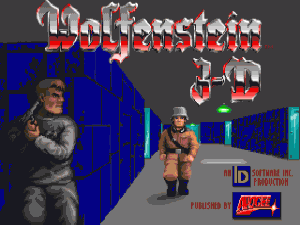
id Software Inc. releases the game Wolfenstein 3D, the original first person shooter game for DOS computers. While it was technically not the first FPS in video game history, Wolfenstein 3D was the game that definitively popularized the genre. Using the shareware model to freely distribute the first of three episodes with the ability to purchase the next two episodes, the game became an instant success, selling 200,000 copies in the first year. The success of Wolfenstein 3D made id Software a household name in the gaming world. They followed up in the next year with the massively popular Doom, which cemented the first person shooter gaming genre and the rest is history.
In addition to being credited with launching the first person shooter genre, Wolfenstein 3D is also widely regarded as proving the viability of and popularizing the shareware distribution model. The game was ported to many different platforms over the years and is still available for purchase to play today.
First American in Space

NASA astronaut Alan Shepard becomes the first American in space when he makes a fifteen minute suborbital flight aboard the Mercury capsule Freedom 7. He reaches an altitude of 115 miles, during which he experiences about five minutes of weightlessness.
Love Stinks
May 4, 2000
The Love Letter computer virus, aka the “ILOVEYOU” bug, spreads to personal computers running Windows around the world in just six hours. Spreading through e-mail, the virus entices victims to open the message with the subject of “ILOVEYOU”. About 2.5 to 3 million PCs will become infected. The cost of system downtime is later estimated at $8.7 billion. It is thought to be the fastest-moving and most widespread virus in history.


